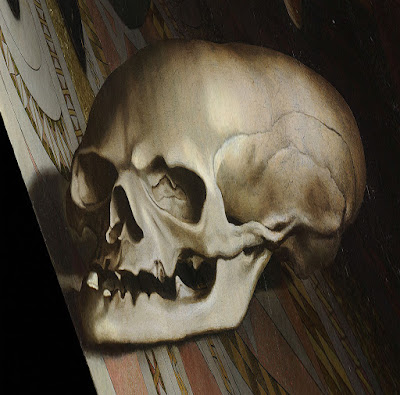The Ambassadors by Hans Holbein the Younger (Interpretation and Analysis)
 |
| The Ambassadors Source: Wikimedia Commons |
At first glance, The Ambassadors is a straightforward portrait of two french diplomats named Jean de Dinteville and Georges de Selve. The two men probably commissioned the painting while working in London, as Holbein spent a considerable portion of his career working in England.
The painting depicts the two men standing in a richly appointed room. Between them, a table holds musical instruments, scientific tools, and books. One of the ambassadors was a member of the clergy, while the other was a landowner. These items represent the secular and sacred knowledge that the two men possess. The items could symbolize the way these two types of knowledge complement each other.
However, the most striking part of the painting is the anamorphic skull near the bottom of the piece. It takes most viewers a few minutes to realize that the distorted bone is actually a skull. It was painted using a technique called anamorphosis, which requires the viewer to stand at a specific vantage point in order to see the image. In this case the skull can only be seen from high on the right side or low on the left side.
The skull is certainly an eerie addition to the piece. It turns the painting into a memento mori, a traditional genre of painting that was designed to remind viewers to live a good life because one day they will die. A tiny crucifix hangs in the top, left-hand corner of the painting, another reminder that there will be judgement after death.
 |
| Detail of the Skull Source: Wikimedia Commons |
It’s unclear why the two ambassadors decided to commission a memento mori as a portrait. The ambassador on the left, Jean de Dinteville, used the phrase memento mori as his motto, which may provide a clue as to the subject of the piece.
Whatever the motive, Holbein certainly succeeded in producing a creepy masterpiece.
Disclaimer: I’m not an art historian or an expert on this topic. The above is my opinion, based on my interpretation of my foreknowledge of art and history. If I’ve done any additional research, I’ll note it above.



Comments
Post a Comment